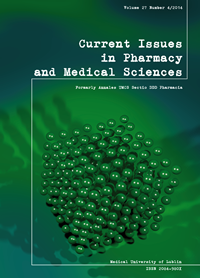Investigation of the hepatoprotective properties of “Phytovenol” capsules on the model of medicamentous hepatitis in rats
DOI:
https://doi.org/10.1515/cipms-2015-0024Keywords:
liver, hepatitis, hepatoprotective action, “Phytovenol” capsulesAbstract
This scientific paper is an investigation of the pharmacological activity of the new medical preparation “Phytovenol” (capsules in the dose of 150 mg/kg) on the pattern of hepatitis in rats induced by paracetamol administration. The authors of the article, for the first time under experimental conditions, detected a hepatoprotective effect that was brought about by “Phytovenol” capsule administration. This is realized due to the antioxidant, antitoxic and anticytolytic activity of the examined medicine. The study found that its efficacy is not lower than the classical hepatoprotector - “Silibor” tablets. The results obtained suggest that it is possible to extend the range of available hepatoprotectors and improve the quality of treatment for liver diseases, by introducing “Phytovenol” capsules into medical practice.
References
1. Kamyshnikov V.S. (2000). Reference book on clinical-biochemical laboratory diagnostics: in two volumes. Minsk: Belarus. V.1.; 495 p.
2. Kamyshnikov V.S. (2000). Reference book on clinical-biochemical laboratory diagnostics: in two volumes. Minsk: Belarus. V.1.; 463 p.
3. Kilham C. The herbal future. C. Kilham. Nutraceuticals world. 20, 7-8, 68-72, 2004.
4. Kim H. Anti-inflammatory plant flavonoids and cellular action mechanisms. H. Kim, K. H. Son, H. W. Chang et al. Journal of pharmacological sciences. 96, 3, 229-245, 2004.
5. Kobzar A.Y. (2007). Pharmacognosy in medicine. Educational manual. Кyiv: Medicine.; 544 p.
6. Masevich Ts.G., Sitkin S.I.: Chronic hepatitis. Tactics of treatment depending on etiology. Aqua Vitae., 23-26, 2000.
7. Mayer K.P. (2000). Hepatitis and consequences of hepatitis: practical guidance. Translation from German; edited by A.A.Sheptulin. Мoscow: Geotar Medicine.; P.157-310.
8. Rybolovlev Yu.R., Rybolovlev R.S. Dosage of substances for mammals by the constants of biological activity. Reports of AS USSR 9. V. 247, No 6, P. 1513-1516, 1979.
9. Stefanov O.V. (2001). Preclinical examinations of medical means (methodical recommendations): Kyiv: Avicenna; 528 p.
10. Stenton G. (1999). Medical-biological statistics: Мoscow: Practice; 459 p.
11. Yakovleva L.V., Gladkova L.V., Tomashevska Yu.O. Examination of membrane stabilizing action of “Phytovenol” capsules on the pattern of spontaneous hemolysis of erythrocytes. 4th National Congress “The Man and Medicines of Ukraine”, 134-135, 2001.
Downloads
Published
Issue
Section
License
Copyright (c) 2015 Authors

This work is licensed under a Creative Commons Attribution-NonCommercial-NoDerivatives 3.0 Unported License.


